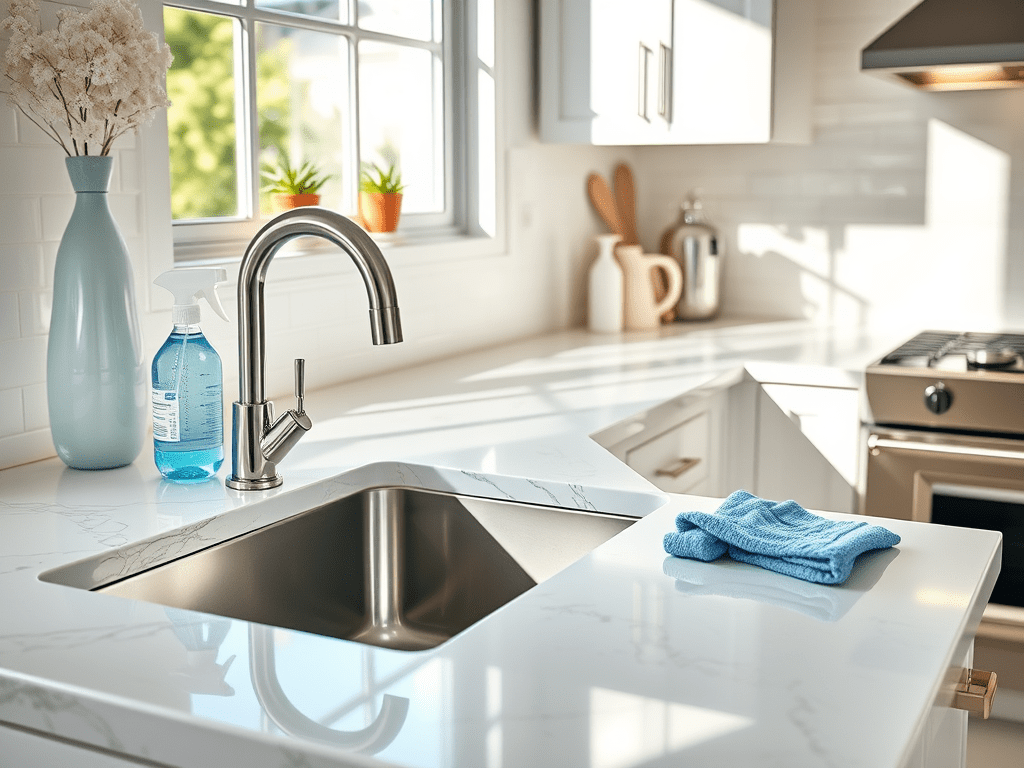Top Kitchen Cleaning Tips: Ultimate Guide for 2025

Keeping your kitchen spotless is easier when you follow the best kitchen cleaning tips. In this guide, we share 17 essential kitchen cleaning tips for 2025 to ensure your kitchen stays clean, hygienic, and organized.
Tip 1: Daily Kitchen Cleaning Tips for Countertops
Start each day by wiping down all countertops, stove tops, and tables using an antibacterial or natural cleaner. Pay special attention to areas around the sink, cutting boards, and food prep zones. Use microfiber clothes for streak-free results. Always wipe in circular motions and finish with a dry cloth to remove any residue.
Tip 2: Kitchen Cleaning Tips for Appliances
Wash dishes immediately after meals using hot water and quality dish soap . For stubborn grease, soak pans in warm water with a bit of baking soda before scrubbing. Dry dishes promptly to prevent water spots and bacterial growth. Consider a dish rack with drainage to keep your sink area dry.
3. Must know Kitchen Cleaning Tips for Deep Cleaning Appliances Weekly
Clean the inside of ovens, microwaves , and refrigerators weekly. Use a paste of baking soda and water to scrub stains inside ovens. Wipe microwaves with a damp cloth and a bit of lemon juice to remove odors. Empty the fridge, discard expired items, and clean shelves with warm soapy water. This ensures your appliances stay hygienic and efficient, it’s a great kitchen cleaning tip.
4. Maintain the Sink
Rinse the sink after every use. Use a disinfectant or vinegar solution to clean the drain and faucet handles. For stainless steel sinks, polish with a mixture of baking soda and water. Periodically remove and clean the sink strainer to prevent clogs and odors.
5. Floor Cleaning Routine
Sweep or vacuum floors daily to remove crumbs and dirt. Mop with a mixture of warm water and gentle floor cleaner at least twice a week. For stubborn spots, use a soft brush or microfiber mop. Ensure corners and under cabinets are included in your routine to prevent hidden buildup.
6. Organize Cabinets and Pantry
Take inventory weekly. Discard expired food, wipe down shelves and rotate items to ensure older products are used first. Use labeled containers to keep dry goods organized. Clear containers make it easy to spot spills or pests. Regular organization prevents clutter and streamlines meal prep.
7. Trash and Recycling Management
Empty trash bins daily to prevent odors and bacteria. Rinse bins weekly with hot soapy water or disinfectant. Label recycling bins for easy separation, and rinse items before disposal. For kitchens with strong smells, sprinkle baking soda at the bottom of the bin.
8. Clean Kitchen Tools Properly
For kitchen cleaning tip number 8 make sure to wash knives, utensils, and cutting boards after each use. Wooden boards benefit from scrubbing with salt and lemon, then occasional oiling with mineral oil to prevent cracking. Sanitize plastic boards with vinegar or a bleach solution. Proper tool maintenance ensures food safety and prolongs the life of your equipment.
9. Focus on High-Germ Areas
Handles, light switches, and refrigerator doors harbor germs. Wipe them daily with disinfecting wipes or sprays. For an added layer, consider an alcohol-based solution. High-touch areas are often overlooked, but cleaning them reduces contamination risks significantly.
10. Regularly Replace Sponges and Cloths
Sponges and dishclothes accumulate bacteria quickly. Replace them weekly or sanitize by microwaving damp sponges for 1 minute. Cloths can be boiled or washed in hot cycles. Using clean materials daily improves surface cleaning efficiency and overall hygiene.
11. Oven and Range Hood Cleaning
Clean your oven interior monthly using baking soda paste or a commercial oven cleaner. Wipe the range hood filters to remove grease and dust buildup. Regular cleaning prevents fire hazards, improves air quality, and keeps cooking areas sparkling.
12. Refrigerator and Freezer Maintenance
Check your fridge and freezer every week. Discard old items and wipe shelves with mild soap. Use a refrigerator coil brush or Vacuum coils behind the refrigerator every 3 months for efficiency. Proper maintenance prevents odors, improves appliance lifespan, and ensures food safety.
13. Dishwasher Care
Clean the dishwasher monthly by running a hot cycle with vinegar or a dishwasher cleaner. Remove and rinse filters regularly. Keeping your dishwasher clean ensures better washing results and prevents mold and unpleasant smells. Using Natruth is also another option.
14. Microwave and Small Appliance Hygiene
Steam clean microwaves by heating a cup of water with lemon slices for 3-5 minutes. Wipe all surfaces with a soft cloth. Regularly clean toaster, blender, and coffee machines according to the manufacturer’s instructions to prevent residue buildup and bacteria growth. Using Shadazzle is another option.
15. Window and Glass Cleaning
Use a vinegar-water solution or a eco friendly glass cleaner to wipe windows, cabinet glass, and mirrors. Dry with a microfiber cloth to avoid streaks. Clean windows monthly and wipe any spills on cabinet glass weekly to maintain a sparkling appearance.
16. Wall and Backsplash Maintenance
Wipe walls and backsplashes weekly using a mild cleaner . Pay attention to grease spots near cooking areas. For tile backsplashes, use a soft brush to scrub grout lines. Maintaining walls and backsplashes keeps the kitchen visually appealing and hygienic.
17. Air Quality and Ventilation
Open windows when cooking to prevent smoke and odors from lingering. Clean air vents monthly and replace filters as needed. A well-ventilated kitchen reduces bacteria and helps keep surfaces dry, preventing mold and mildew. A home air purifier works wonders as well.
Final Thoughts on Kitchen Cleaning Tips
Consistent cleaning habits, organized storage, and attention to high-touch areas make all the difference. Implement these kitchen cleaning tips today and enjoy a cleaner, healthier, and more inviting kitchen. Explore more blogs on our site to expand your home care knowledge: Behind the Recipes.
Internal and External Resources
For more guidance on maintaining a healthy kitchen, check our Behind the Recipes blog. External resources such as CDC Food Safety provide expert advice for hygiene and food handling.
Deep Cleaning Your Kitchen: Historical Tips and Modern Tricks
Deep cleaning your kitchen is about more than just surface scrubbing; it’s about revitalizing the heart of your home with methods that have stood the test of time. Some of the most effective cleaners we use today have a rich history, and their effectiveness has been celebrated for centuries. Ingredients like vinegar, baking soda, lemon juice, and even salt have been essential for cleaning long before chemical products were available.
Vinegar has been used for thousands of years, dating back to ancient Babylon, where it was prized not only as a condiment but also as a natural disinfectant. Its acidic nature makes it excellent for cutting through grease, removing mineral deposits, and eliminating odors. Modern kitchens still rely on vinegar for cleaning countertops, sinks, microwaves, and even coffee makers.
Baking soda, or sodium bicarbonate, not originally for kitchen cleaning was first discovered in Egypt as a naturally occurring mineral used for mummification and as an early soap alternative. Today, it’s known as a gentle abrasive that can lift stains from surfaces without scratching them. It also deodorizes and neutralizes acids and odors, making it perfect for refrigerators, cutting boards, and ovens.
Lemon juice, with its natural citric acid, has been used historically to brighten surfaces and remove stains. Ancient Romans and Greeks valued it for its antibacterial properties, and today it’s a popular ingredient for polishing copper pots, cleaning cutting boards, and freshening drains. Combined with vinegar or baking soda, lemon juice becomes an unstoppable natural cleaning agent.
Salt, often overlooked, has been used for centuries as a scrubbing agent. Its coarse texture helps to remove burnt-on residues from cast iron pans, enamel cookware, and even wooden cutting boards. It also acts as a preservative, keeping certain cleaning solutions active and effective over time.
When deep cleaning your kitchen, start with a plan. Begin at the top and work your way down, so dust and debris from cabinets and shelves don’t land on freshly cleaned countertops. Cabinets, shelves, and pantry spaces benefit from a solution of vinegar and water or mild dish soap. Wipe down the insides, remove crumbs, and organize items to maintain cleanliness.
Appliances require special attention. Refrigerators should be emptied and cleaned with a mixture of water and baking soda to neutralize odors. Ovens and microwaves respond well to a paste of baking soda and water left to sit, then scrubbed away. Stainless steel appliances shine when wiped with a vinegar solution and microfiber cloth.
Sinks and faucets often harbor hidden grime. Use a combination of lemon juice and baking soda to scrub faucets and sink basins. For drains, pouring a mixture of baking soda followed by vinegar can remove buildup and deodorize naturally, followed by hot water to flush everything through.
Floors and walls also deserve attention. Tile or linoleum floors respond well to a vinegar-water solution, while wooden floors benefit from a damp mop with a mild detergent. Walls, particularly behind stoves and counters, can be wiped with a mixture of dish soap and water to remove grease splatters and fingerprints.
Don’t forget smaller items like cutting boards, utensils, and cookware. Wooden cutting boards can be scrubbed with salt and lemon juice to remove odors and stains. Cast iron pans should be scrubbed with salt and a stiff brush to remove residue without stripping seasoning. Ceramic and enamel cookware can be soaked in a mixture of vinegar and water to loosen stubborn stains.
For truly stubborn stains or residues, a combination approach often works best. Sprinkle baking soda over the area, spray with vinegar, and let the fizzing action lift grime. This method works wonders on countertops, sinks, ovens, and even stovetops. Finish with a warm damp cloth to rinse thoroughly and dry to prevent streaks.
Regular deep cleaning not only improves the aesthetics of your kitchen but also enhances food safety and overall hygiene. Creating a routine, even once a month, ensures that hidden grime doesn’t accumulate and that the tools you rely on daily remain safe and effective. By combining modern techniques with historical wisdom, your kitchen can achieve a level of cleanliness that feels both natural and deeply satisfying.
Exploring the history of common cleaning agents gives a deeper appreciation for the resources we often take for granted. From vinegar to baking soda, these simple ingredients have been helping kitchens shine for centuries, proving that effective cleaning doesn’t always require complex or harsh chemicals. Integrating these natural solutions into your routine will leave your kitchen sparkling, fresh, and ready for any culinary adventure.
For more expert kitchen cleaning tips and additional guides on maintaining a spotless and organized kitchen, explore other articles on our site: Behind the Recipes. Keep your kitchen safe, clean, and inspiring with a mix of historical wisdom and modern efficiency.
